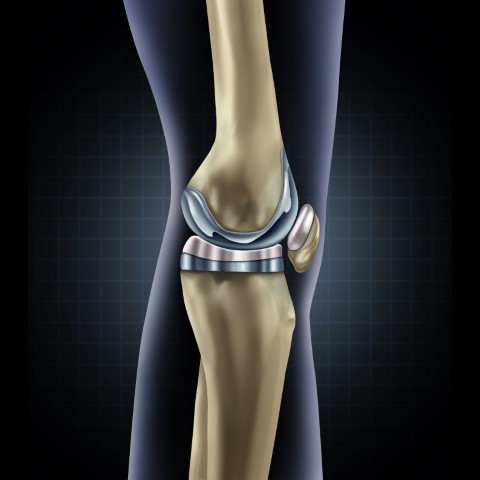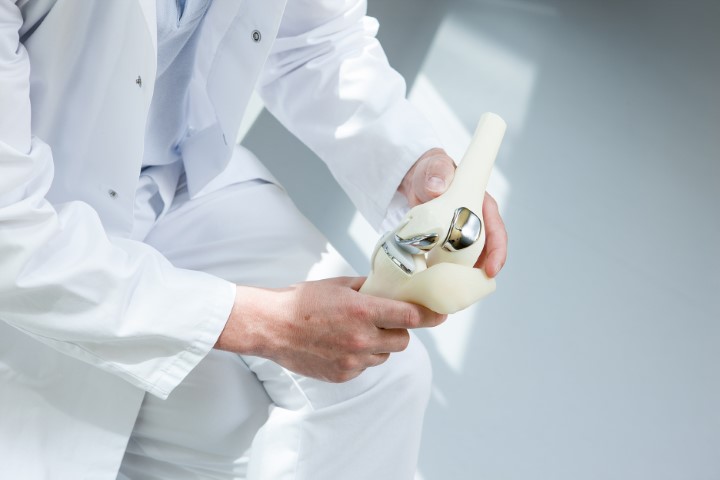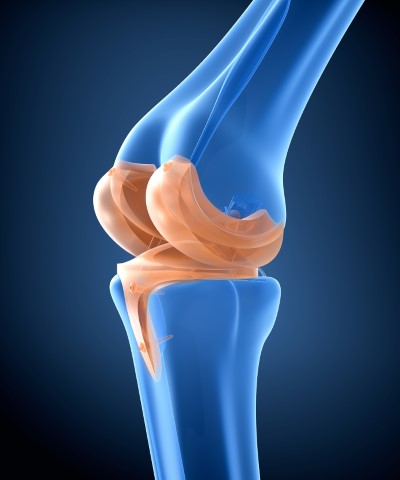Dr. Chandrashekhar P, Director & Head of Orthopedics, Sakra World Hospital, Bengaluru, a specialist in Robotic Knee Replacement surgery, explains about patients experiencing lesser pain after Robotic Knee Replacement and the success rate of robotic knee replacement surgery.
Knee replacement, also known as knee arthroplasty, is a surgical procedure done to reverse knee damage, to relieve pain and disability caused by conditions such as arthritis. For people suffering from severe knee pain caused by osteoarthritis, rheumatoid arthritis, or any other similar ailment, knee replacement surgery may be able to offer relief. Whether you need to undergo a surgical procedure or not is a decision that you and your doctor will collectively take.
The procedure for knee replacement involves cutting away the damaged bone and cartilage and replacing it with an artificial joint made of metal or plastic polymer.
The treatment methods for arthritis and other conditions as such are advancing day by day and providing better and more optimal long-term relief. This is where the futuristic robotic knee replacement surgery comes in. A lot of people have queries about the procedure and its after-effects. Here are 5 important things you should know about Robotic Knee Replacement Surgery.



- A robot does not perform the surgery
The robotic technology’s state-of-the-art 3D software lets your surgeon design and plan the surgery much in advance, making necessary adjustments in real-time to provide a more precise alignment of the implant as compared to conventional non-robotic partial knee replacement.
While up to 20% of patients are not happy with the outcome following Knee Replacement surgery, the use of a robot as an additional surgical tool helps the surgeon during all stages of the knee replacement surgery and helps in delivering the best possible outcome.
- Improved accuracy
Robotic assistance technology enhances the surgeon’s expertise, preventing accidental surrounding tissue damage aiding in greater precision during surgery. It helps the surgeon to pre-plan bone cuts and implant sizes, unique to your anatomy.
The 3D images of the knee obtained through a CT scan help the surgeon to specialize and prepare for the surgery. These images help the doctor to plan for the optimal type of implant and the accurate placement of the same. Robotic knee replacement surgery acts as a guide, helping your surgeon to follow a laid-out plan much in advance, as compared to traditional knee replacement surgery.
- Faster Recovery
The robotic arm helps with lesser tissue trauma as well as minimal bone and blood loss, as it follows the specified dimensions set before surgery. This helps with faster recovery and lesser post-operative pain. It also allows the implant to be placed with precision, therefore increasing the overall longevity of the new joint. Due to greater accuracy, there are fewer complications and hence a lower chance of revision surgery.
- Candidature varies
If you are a candidate for traditional knee replacement surgery, chances are you are a likely candidate for robotic knee replacement surgery. It is equally important to talk with your doctor to evaluate your surgical and non-surgical options.
Depending on the severity of your condition, your doctor may or may not recommend surgery. They might also recommend less invasive treatment methods first like anti-inflammatory medications, weight loss through diet or exercise, physical therapy, cortisone shots, and or knee braces. If these are unable to help significantly, knee replacement surgery may help. Robotic knee replacement means more accurate implant positioning, which is a plus for middle-aged patients who can undergo knee replacement surgery and get back to their usual active lifestyle.
Having said that, it is always recommended to discuss all the possible options with your surgeon, irrespective of your age, and then opt for knee replacement surgery is suggested.
- Lesser Risk
With traditional surgery, there is only a 2% chance that serious complications may occur. Robotic knee replacement surgery comes with the same risks as traditional knee replacement surgery, namely:
- Infections
- Nerve damage
- Allergic reactions to the materials used in the artificial joints
- Deep vein thrombosis (blood clots)
Although robotic knee replacement procedures require a smaller incision and potentially can be performed with greater accuracy, doctors are hopeful that these risks can be significantly reduced.
Because knee replacement surgeries have been using the traditional approach way longer than the robotic approach, more benefits of robotic joint replacement surgery are yet to be understood and validated with data. Need for more research is essential to determine whether or not robotic-assisted technology is as effective for total knee replacement. Robotic Knee Replacement Surgery is all about optimal execution and implant positioning, which leads to a better and faster recovery. So, make sure you take your doctor’s advice and make an informed decision.
Do you often skip taking the stairs and opt for elevators because of your knee pain? Does walking few meters feels like too much? If so then you are not alone, you are one of the millions of people who have been suffering from chronic knee pain. There is no point in sugar-coating it as we all know knee pain ruins the fun in life. The positive news is there are options available for those who are suffering from pain. At first, most doctors will try to treat in non-invasive ways that are non-steroidal anti-inflammatory drugs, therapy, or these days even stem cell-derived growth factor injection but if your knee pain is disabling and alternative treatments are not working, knee replacement surgery might be the best route for you.
A knee replacement surgery can be life-altering for patients with knee pain. This surgery eliminates pain and helps restore mobility so that the patients can resume their active lifestyle. A knee replacement surgery might sound intimidating but advanced technology has made this procedure more effective with the best outcomes. This can be performed in a conventional way where the surgeon seats the implants manually or with the assistance of a robotic arm controlled by the surgeon. Let us understand the difference between these procedures so that they can help you be more at ease.
Traditional Knee Replacement Surgery
Traditional knee replacement surgery has been existing for more than 70 years. This technique typically replaces only a part of the joint. Based on the x-ray an experienced surgeon will carefully examine the correct alignment and positioning for the metal implant. The surgeon then cements the prosthesis and all this is done manually by a surgeon. This replaces the damaged part of the knee which results in more natural feeling and movement. It facilitates quicker recovery and returns to normal activities.
Conventional knee replacement surgery started a revolution in the medical sector and with advanced research and development new forms of surgery have come up to benefit the patients in a better and effective way. It is one step ahead of traditional knee replacement surgery. With the intervention of robotics in medical science it has given another direction, it has touched the orthopedic sector and has proven beneficial in bringing effective results for the patients undergoing robotic knee replacement surgery.



Do you often skip taking the stairs and opt for elevators because of your knee pain? Does walking few meters feels like too much? If so then you are not alone, you are one of the millions of people who have been suffering from chronic knee pain. There is no point in sugar-coating it as we all know knee pain ruins the fun in life. The positive news is there are options available for those who are suffering from pain. At first, most doctors will try to treat in non-invasive ways that are non-steroidal anti-inflammatory drugs, therapy, or these days even stem cell-derived growth factor injection but if your knee pain is disabling and alternative treatments are not working, knee replacement surgery might be the best route for you.
A knee replacement surgery can be life-altering for patients with knee pain. This surgery eliminates pain and helps restore mobility so that the patients can resume their active lifestyle. A knee replacement surgery might sound intimidating but advanced technology has made this procedure more effective with the best outcomes. This can be performed in a conventional way where the surgeon seats the implants manually or with the assistance of a robotic arm controlled by the surgeon. Let us understand the difference between these procedures so that they can help you be more at ease.
Traditional Knee Replacement Surgery
Traditional knee replacement surgery has been existing for more than 70 years. This technique typically replaces only a part of the joint. Based on the x-ray an experienced surgeon will carefully examine the correct alignment and positioning for the metal implant. The surgeon then cements the prosthesis and all this is done manually by a surgeon. This replaces the damaged part of the knee which results in more natural feeling and movement. It facilitates quicker recovery and returns to normal activities.
Conventional knee replacement surgery started a revolution in the medical sector and with advanced research and development new forms of surgery have come up to benefit the patients in a better and effective way. It is one step ahead of traditional knee replacement surgery. With the intervention of robotics in medical science it has given another direction, it has touched the orthopedic sector and has proven beneficial in bringing effective results for the patients undergoing robotic knee replacement surgery.
Suffering from severe arthritis of the knees can be a tedious condition with consistent symptoms such as pain in the knees that worsens over time, stiffness, swelling of joints, etc. These persistent symptoms can become a hindrance in one’s day-to-day functioning.
Non-operative treatments like knee joint injections, activity modification, and anti-inflammatory medications can be the first option for most people, but when these have failed to provide adequate relief, Knee replacement surgery can be of help.
Knee replacement, also known as knee arthroplasty or total knee replacement, is a surgical procedure to resurface a knee damaged by arthritis. Metal and plastic parts are used to cap the ends of the bones that form the knee joint, along with the kneecap.
Traditional total knee replacement involves an incision over the knee of about 7-8 inches, and a recovery period of 3-5 days at the hospital.



According to an article by UW Medicine Orthopaedics & Sports Medicine on Total Knee Replacement surgery most reports of surgeons performing knee replacement surgery have been excellent and the results have shown ten-year success rates above 90 percent.
More than 90 percent of total knee replacement patients experience substantial or complete relief of pain once they have recovered from the procedure. The large majority do not require a cane even if there is the one used before the surgery and can walk without a limp.



The major benefit of total knee replacement surgery is the better quality of life. There is a restoration of the ability to carry out activities that they could not do before, due to the pain and stiffness, etc. The pain and the stiffness from the arthritis are relieved by the surgery. It is reported that the distance one can walk will improve well because of the diminished pain.
One major complication that can hinder a total knee replacement surgery is the patient’s allergy to metal components. Some people may experience a reaction to the metal that is used in the artificial knee joint as implants may contain titanium or cobalt-chromium-based alloy. This is where Gold Knee Implants come in.
What are Gold Knee Implants?
For patients who have shown an allergic reaction to metals, the Gold knee replacement procedure can be considered a very good option. The knee implants used for the surgery have a Titanium Niobium Nitride (TiNbN) coating on their surface. This coating gives a golden color to the implant and makes it allergy-proof because of inert material’s coating.
Why one should opt for Gold Knee Implants?
The implant gold knee is one of the best artificial joint. It has a longer life span and does not trigger any allergic reactions. According to an article by Bone and Joint 360 the Golden knee implant is compatible with human tissues, and it is highly recommended for patients that are 60 years of age or below.
Knee implants are normally made of an alloy of chromium and cobalt and sometimes they tend to release metal ions inside your body. Patients who may experience an allergic reaction tend to experience inflammation in the knee joint because of the same. Eventually, complications like infections, loosening of the joint, and persisting knee pain develop.
Benefits of a Gold Knee Implant
- Durable implants due to the titanium coating.
- The higher life span of the Gold Knee implant as compared to regular knee implants.
- Works well with new-age surgical techniques. The outcomes are better when compared to regular implants.
There are various types of implants used other than Gold Knee Implants as well, such as metal on plastic implants, which are the most common type of implants, or ceramic on plastic implants, for people who have a sensitivity to nickel used in metal implants, leading to an allergic reaction or people who are sensitive to nickel used in metal implants.
It is important to evaluate all your options before opting for a total knee replacement surgery, the cost, the biocompatibility, and especially about the type of metal that is used, in case the patient is allergic to a certain metal or alloy.
After meeting with a bike accident, learning about the Arthritis problem, and overcoming the fear of Knee Replacement Surgery, and opting for the same; I, Ashwini Karnawat came a long way at a young age only to learn that it was all worth it! Here’s how proper medical guidance and care did wonders and helped me bounce back better.





